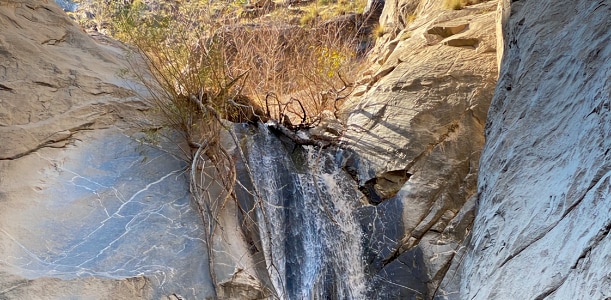
Hiking on the Tahquitz Canyon Trail
Tahquitz Canyon Trail
by InlandValleyLiving.Com
We found a perfect way to start a new family experience by hiking the Tahquitz Canyon Trail located in Palm Springs. The day, weather and views were perfect. Our group which consisted of my wife, son and I took our time heading towards the 60 foot waterfall. The water was cold, but yes you can jump in. TIP | plan a head by taking towels and a swim suit.
Video Exclusive
Tahquitz Canyon is described as one of the most beautiful and culturally sensitive areas of the Agua Caliente Band of Cahuilla Indians Reservation. Tahquitz Canyon is home to a spectacular seasonal 60-foot waterfall, rock art, ancient irrigation systems, native wildlife, and plants. Located at the entrance to the canyon, the Tahquitz Canyon Visitor Center offers educational and cultural exhibits.
From Their Website: Agua Caliente History
Since time immemorial, the Agua Caliente Band of Cahuilla Indians has called the Palm Springs area home. Long ago, they built complex communities in the Palm, Murray, Andreas, Tahquitz and Chino canyons. With an abundant water supply, the plants, animals and Agua Caliente Indians thrived. They grew crops of melons, squash, beans and corn. They gathered plants and seeds for food, medicines and basket weaving. Today, remnants of the early Agua Caliente society such as rock art, house pits, foundations, irrigation ditches, dams, reservoirs, trails and food preparation areas still exist in the canyons.
The Agua Caliente Indians have always been industrious and creative with a reputation for independence, integrity and peace. In 1876 and 1877, the U.S. Federal Government deed in trust to the Agua Caliente people 31,500 acres for their homeland. The Federal Government previously gave the Southern California Railroad 10 miles of odd-numbered sections of land to induce the company to build the railroad. Of the Agua Caliente Indian Reservation’s 31,500 acres, about 6,700 acres are within the Palm Springs city limits. The remaining sections span across the desert and mountains in a checkerboard pattern.
As early as the 1900s, Palm Springs and the surrounding area have been described as a recreational oasis. Tahquitz Canyon and the Indian Canyons are listed on the National Register of Historic Places. Palm Canyon in the Indian Canyons is the world’s largest Washingtonia filifera (California Fan Palm) oasis.
Tahquitz was the first shaman created by Mukat, the creator of all things. Tahquitz had much power, and in the beginning he used his power for the good of all people. Tahquitz became the guardian spirit of all shamans and he gave them power to do good. But over time, Tahquitz began to use his power for selfish reasons. He began to use his power to harm the Cahuilla People. The people became angry, and they banished Tahquitz to this canyon that now bears his name. He made his home high in the San Jacinto Mountains in a secret cave below the towering rock known today as Tahquitz Peak. It is said that his spirit still lives in this canyon. He can sometimes be seen as a large green fireball streaking across the night sky. The strange rumblings heard deep within the San Jacinto Mountains, the shaking of the ground, and the crashing of boulders are all attributed to Tahquitz as he stomps about the canyon.
THE LEGEND
Tahquitz was the first shaman created by Mukat, the creator of all things. Tahquitz had much power, and in the beginning he used his power for the good of all people. Tahquitz became the guardian spirit of all shamans and he gave them power to do good. But over time, Tahquitz began to use his power for selfish reasons. He began to use his power to harm the Cahuilla People. The people became angry, and they banished Tahquitz to this canyon that now bears his name. He made his home high in the San Jacinto Mountains in a secret cave below the towering rock known today as Tahquitz Peak. It is said that his spirit still lives in this canyon. He can sometimes be seen as a large green fireball streaking across the night sky. The strange rumblings heard deep within the San Jacinto Mountains, the shaking of the ground, and the crashing of boulders are all attributed to Tahquitz as he stomps about the canyon.


[flickr_set id=”72157713240988973″]
There is a cost to hike the trail, see blow rates below.
Admission
Adults . . . . . . . . . . . . . . . $12.50
Children (6-12) . . . . . . . . . $6
Military . . . . . . . . . . . . . . . Free (with U.S. military ID)
Six-Month Pass . . . . . . . . .$60
Annual Pass . . . . . . . . . . . $90
Group rates available. Prices subject to change. For information call 760-323-6018.
Note: Hours and hike schedule are subject to change.
Hours
Oct. 1 – July 4 – 7:30 a.m. – 5 p.m. daily (Last hiker on trail at 3:30 p.m.)
July 5- Sept. 30 – 7:30 a.m. – 5 p.m. open only Fridays Saturdays and Sundays (Last hiker on trail at 3:30 p.m.)
No animals allowed.

